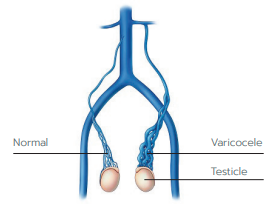Varicocele embolisation
A varicocele is an enlargement of the veins surrounding the testicle, which results from abnormal (reversed) blood flow causing congestion (venous incompetence). Varicoceles are usually left sided, and can cause local swelling, pain and discomfort, and may be associated with infertility
 Varicocele embolisation is a procedure in which the abnormal vein(s) are blocked, preventing blood flow from occurring in the wrong direction. Over time, this reduces congestion and causes the varicocele to disappear. When the abnormal veins are blocked, the testicles will continue to drain blood normally by other routes
Varicocele embolisation is a procedure in which the abnormal vein(s) are blocked, preventing blood flow from occurring in the wrong direction. Over time, this reduces congestion and causes the varicocele to disappear. When the abnormal veins are blocked, the testicles will continue to drain blood normally by other routes